Procurement Methods: Best Value, Design-Bid-Build, and IPD
VerifiedAdded on 2023/06/04
|18
|3359
|90
Report
AI Summary
This procurement report provides a comprehensive analysis of three key construction procurement methods: Best Value Source Selection, Design-Bid-Build, and Integrated Project Delivery (IPD). The report begins with an executive summary and introduction, defining procurement methods and their significance in construction projects. It then delves into each method, detailing their advantages, disadvantages, and the relationships between stakeholders involved. For Best Value, the report highlights the competitive bidding process and its suitability for specific procurement scenarios. The Design-Bid-Build method is explored, emphasizing its three stages, stakeholder roles, and the owner's control over the project. Finally, the report examines IPD, focusing on its collaborative approach, technological integration (BIM), and the sharing of risks and rewards among stakeholders. The report concludes with an overview of the advantages, disadvantages, and the most appropriate applications of each method, including a list of references.

Procurement Report 1
Procurement Report
Name:
Institution:
Course:
Tutor:
Date:
Procurement Report
Name:
Institution:
Course:
Tutor:
Date:
Paraphrase This Document
Need a fresh take? Get an instant paraphrase of this document with our AI Paraphraser
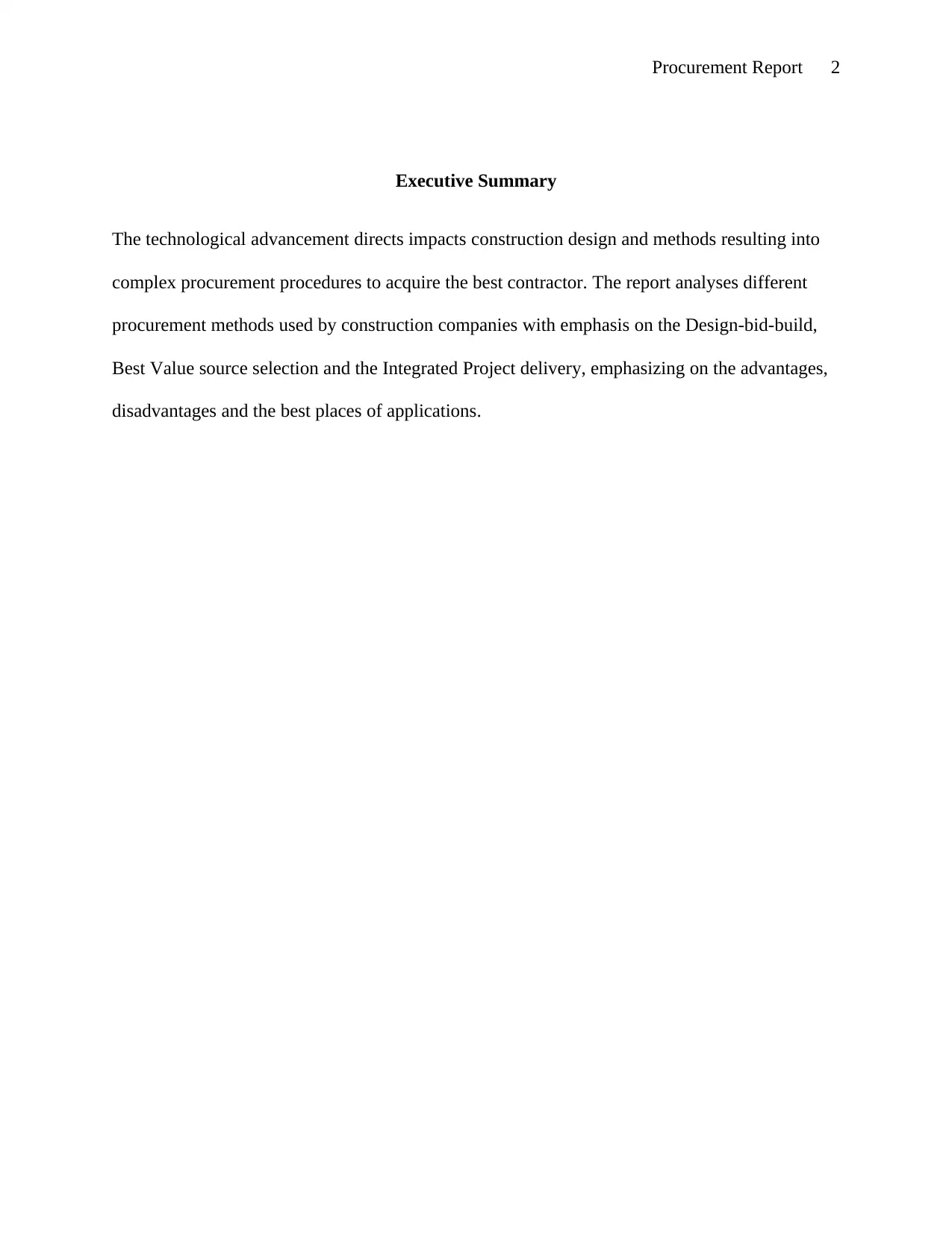
Procurement Report 2
Executive Summary
The technological advancement directs impacts construction design and methods resulting into
complex procurement procedures to acquire the best contractor. The report analyses different
procurement methods used by construction companies with emphasis on the Design-bid-build,
Best Value source selection and the Integrated Project delivery, emphasizing on the advantages,
disadvantages and the best places of applications.
Executive Summary
The technological advancement directs impacts construction design and methods resulting into
complex procurement procedures to acquire the best contractor. The report analyses different
procurement methods used by construction companies with emphasis on the Design-bid-build,
Best Value source selection and the Integrated Project delivery, emphasizing on the advantages,
disadvantages and the best places of applications.
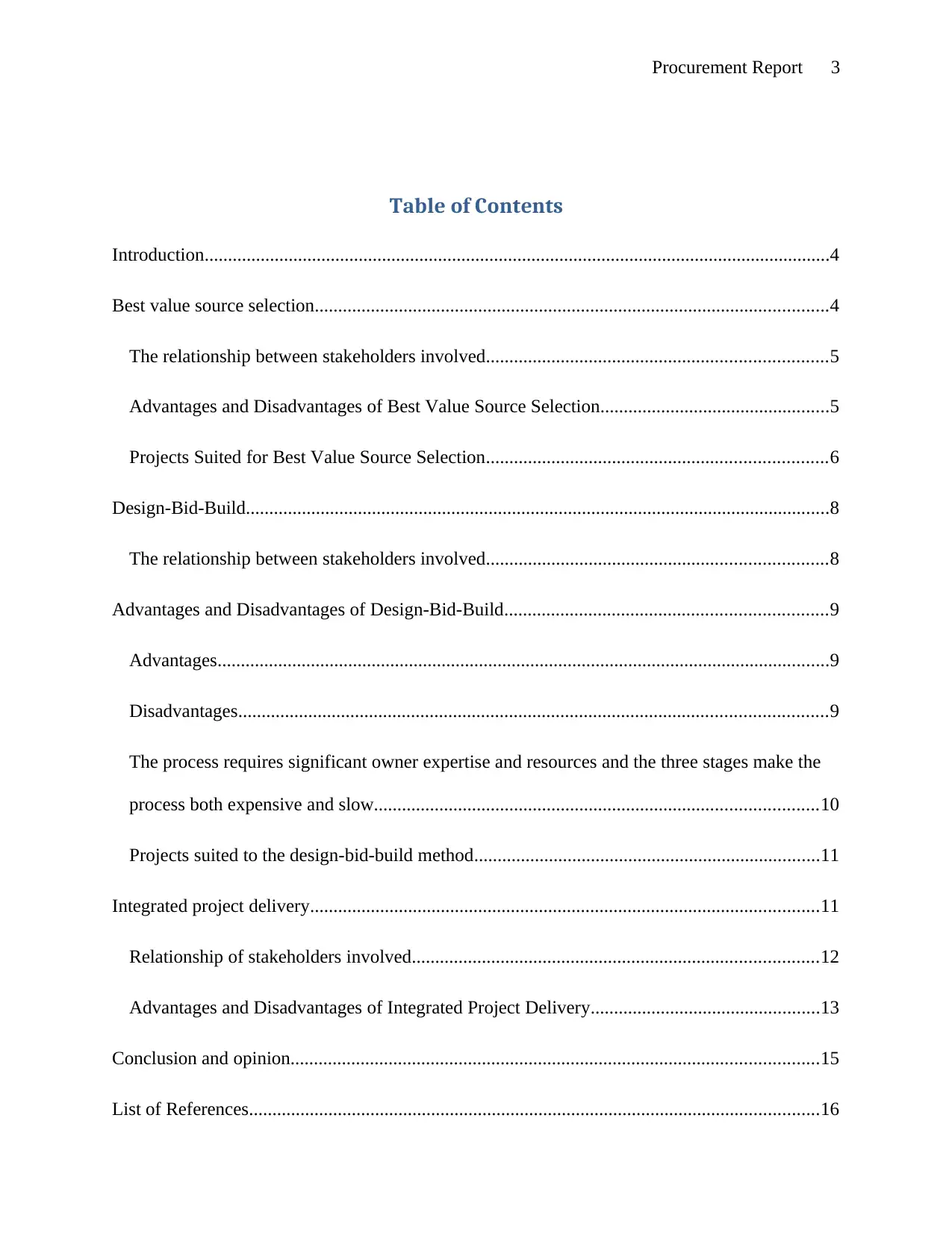
Procurement Report 3
Table of Contents
Introduction......................................................................................................................................4
Best value source selection..............................................................................................................4
The relationship between stakeholders involved.........................................................................5
Advantages and Disadvantages of Best Value Source Selection.................................................5
Projects Suited for Best Value Source Selection.........................................................................6
Design-Bid-Build.............................................................................................................................8
The relationship between stakeholders involved.........................................................................8
Advantages and Disadvantages of Design-Bid-Build.....................................................................9
Advantages...................................................................................................................................9
Disadvantages..............................................................................................................................9
The process requires significant owner expertise and resources and the three stages make the
process both expensive and slow...............................................................................................10
Projects suited to the design-bid-build method..........................................................................11
Integrated project delivery.............................................................................................................11
Relationship of stakeholders involved.......................................................................................12
Advantages and Disadvantages of Integrated Project Delivery.................................................13
Conclusion and opinion.................................................................................................................15
List of References..........................................................................................................................16
Table of Contents
Introduction......................................................................................................................................4
Best value source selection..............................................................................................................4
The relationship between stakeholders involved.........................................................................5
Advantages and Disadvantages of Best Value Source Selection.................................................5
Projects Suited for Best Value Source Selection.........................................................................6
Design-Bid-Build.............................................................................................................................8
The relationship between stakeholders involved.........................................................................8
Advantages and Disadvantages of Design-Bid-Build.....................................................................9
Advantages...................................................................................................................................9
Disadvantages..............................................................................................................................9
The process requires significant owner expertise and resources and the three stages make the
process both expensive and slow...............................................................................................10
Projects suited to the design-bid-build method..........................................................................11
Integrated project delivery.............................................................................................................11
Relationship of stakeholders involved.......................................................................................12
Advantages and Disadvantages of Integrated Project Delivery.................................................13
Conclusion and opinion.................................................................................................................15
List of References..........................................................................................................................16
⊘ This is a preview!⊘
Do you want full access?
Subscribe today to unlock all pages.

Trusted by 1+ million students worldwide
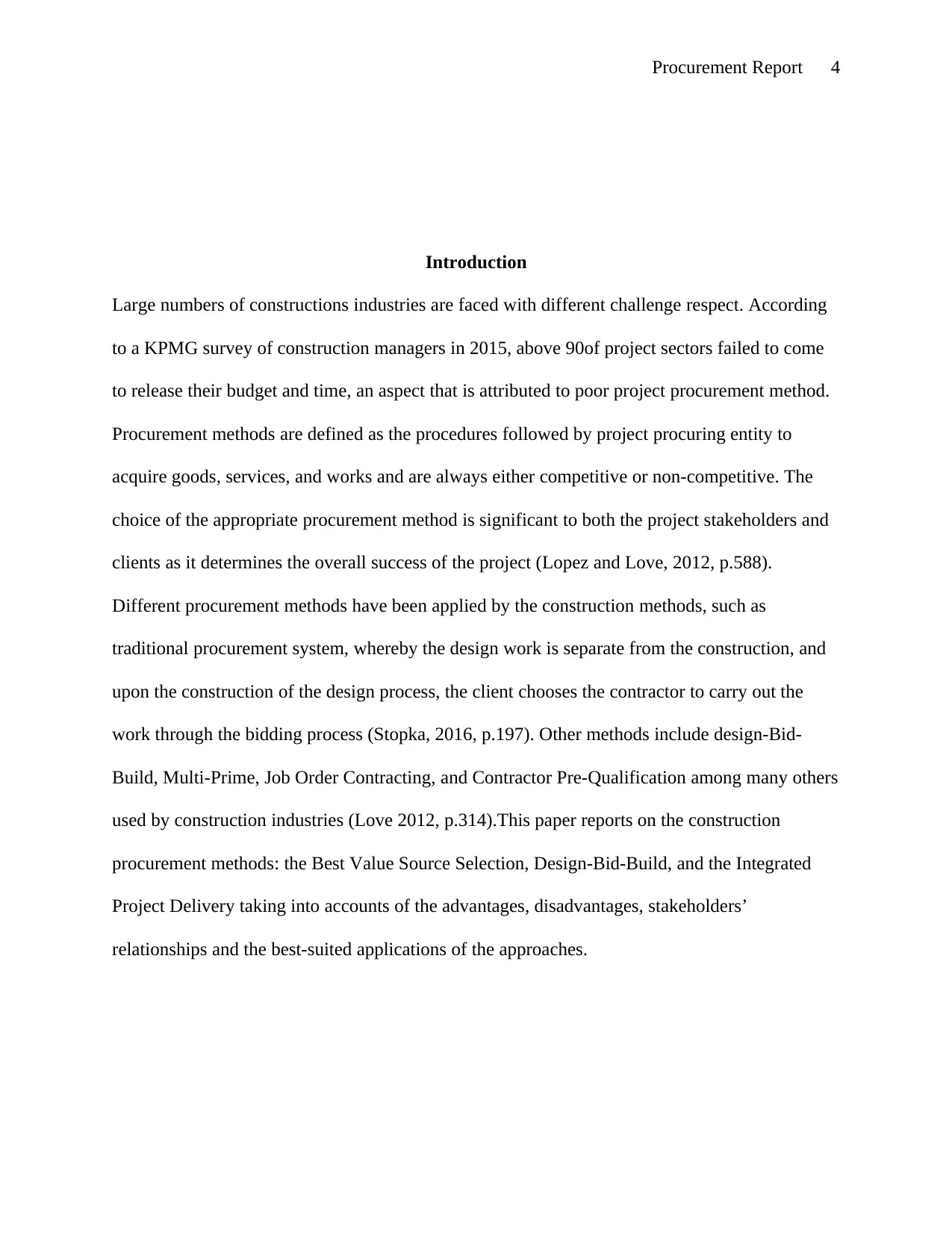
Procurement Report 4
Introduction
Large numbers of constructions industries are faced with different challenge respect. According
to a KPMG survey of construction managers in 2015, above 90of project sectors failed to come
to release their budget and time, an aspect that is attributed to poor project procurement method.
Procurement methods are defined as the procedures followed by project procuring entity to
acquire goods, services, and works and are always either competitive or non-competitive. The
choice of the appropriate procurement method is significant to both the project stakeholders and
clients as it determines the overall success of the project (Lopez and Love, 2012, p.588).
Different procurement methods have been applied by the construction methods, such as
traditional procurement system, whereby the design work is separate from the construction, and
upon the construction of the design process, the client chooses the contractor to carry out the
work through the bidding process (Stopka, 2016, p.197). Other methods include design-Bid-
Build, Multi-Prime, Job Order Contracting, and Contractor Pre-Qualification among many others
used by construction industries (Love 2012, p.314).This paper reports on the construction
procurement methods: the Best Value Source Selection, Design-Bid-Build, and the Integrated
Project Delivery taking into accounts of the advantages, disadvantages, stakeholders’
relationships and the best-suited applications of the approaches.
Introduction
Large numbers of constructions industries are faced with different challenge respect. According
to a KPMG survey of construction managers in 2015, above 90of project sectors failed to come
to release their budget and time, an aspect that is attributed to poor project procurement method.
Procurement methods are defined as the procedures followed by project procuring entity to
acquire goods, services, and works and are always either competitive or non-competitive. The
choice of the appropriate procurement method is significant to both the project stakeholders and
clients as it determines the overall success of the project (Lopez and Love, 2012, p.588).
Different procurement methods have been applied by the construction methods, such as
traditional procurement system, whereby the design work is separate from the construction, and
upon the construction of the design process, the client chooses the contractor to carry out the
work through the bidding process (Stopka, 2016, p.197). Other methods include design-Bid-
Build, Multi-Prime, Job Order Contracting, and Contractor Pre-Qualification among many others
used by construction industries (Love 2012, p.314).This paper reports on the construction
procurement methods: the Best Value Source Selection, Design-Bid-Build, and the Integrated
Project Delivery taking into accounts of the advantages, disadvantages, stakeholders’
relationships and the best-suited applications of the approaches.
Paraphrase This Document
Need a fresh take? Get an instant paraphrase of this document with our AI Paraphraser

Procurement Report 5
Best value source selection
Source selection is a competitive method whereby the best alternative gets the opportunity to
undertake the construction of a project. Most companies apply two significant approaches to
source selection: lowest value and best value (Schultz and Dotson 2015, p.22). The use of the
lower cost approach is common in most instances, whereby the cost of the overall is compared to
other alternatives and the tender awarded to the one that offers the lowest price of construction
(Yu and Wang 2012, p.129). On the other hand, the best value approach in a simple term refers
to the competitive negotiation contracting method whereby the selection is based on most
advantageous offers by evaluation and comparison of factors other than price. The approach is
always perceived as expensive and sophisticated due to the entailed in-depth planning,
documentation and personnel requirement. Best Value Approach offers activities flexibility,
innovativeness and individualized solutions that can meet the performance.
The relationship between stakeholders involved
The stakeholders involved comprise of the owner and the products/service providers. During the
process, the owner determines the minimum qualities required and the contractors offer their
available qualities from which the owner chooses the most appropriate according to the
stipulated requirements.
Advantages and Disadvantages of Best Value Source Selection
Advantages Disadvantages
The competitive e bidding process offers a
wide range of qualities and values to be chosen
from, hence results into high qualified
contractor
The process is time-consuming since it
involves the invitations of the bidders, the
evaluation and the choice of the appropriate
that has all the procurement requirements
Best value source selection
Source selection is a competitive method whereby the best alternative gets the opportunity to
undertake the construction of a project. Most companies apply two significant approaches to
source selection: lowest value and best value (Schultz and Dotson 2015, p.22). The use of the
lower cost approach is common in most instances, whereby the cost of the overall is compared to
other alternatives and the tender awarded to the one that offers the lowest price of construction
(Yu and Wang 2012, p.129). On the other hand, the best value approach in a simple term refers
to the competitive negotiation contracting method whereby the selection is based on most
advantageous offers by evaluation and comparison of factors other than price. The approach is
always perceived as expensive and sophisticated due to the entailed in-depth planning,
documentation and personnel requirement. Best Value Approach offers activities flexibility,
innovativeness and individualized solutions that can meet the performance.
The relationship between stakeholders involved
The stakeholders involved comprise of the owner and the products/service providers. During the
process, the owner determines the minimum qualities required and the contractors offer their
available qualities from which the owner chooses the most appropriate according to the
stipulated requirements.
Advantages and Disadvantages of Best Value Source Selection
Advantages Disadvantages
The competitive e bidding process offers a
wide range of qualities and values to be chosen
from, hence results into high qualified
contractor
The process is time-consuming since it
involves the invitations of the bidders, the
evaluation and the choice of the appropriate
that has all the procurement requirements
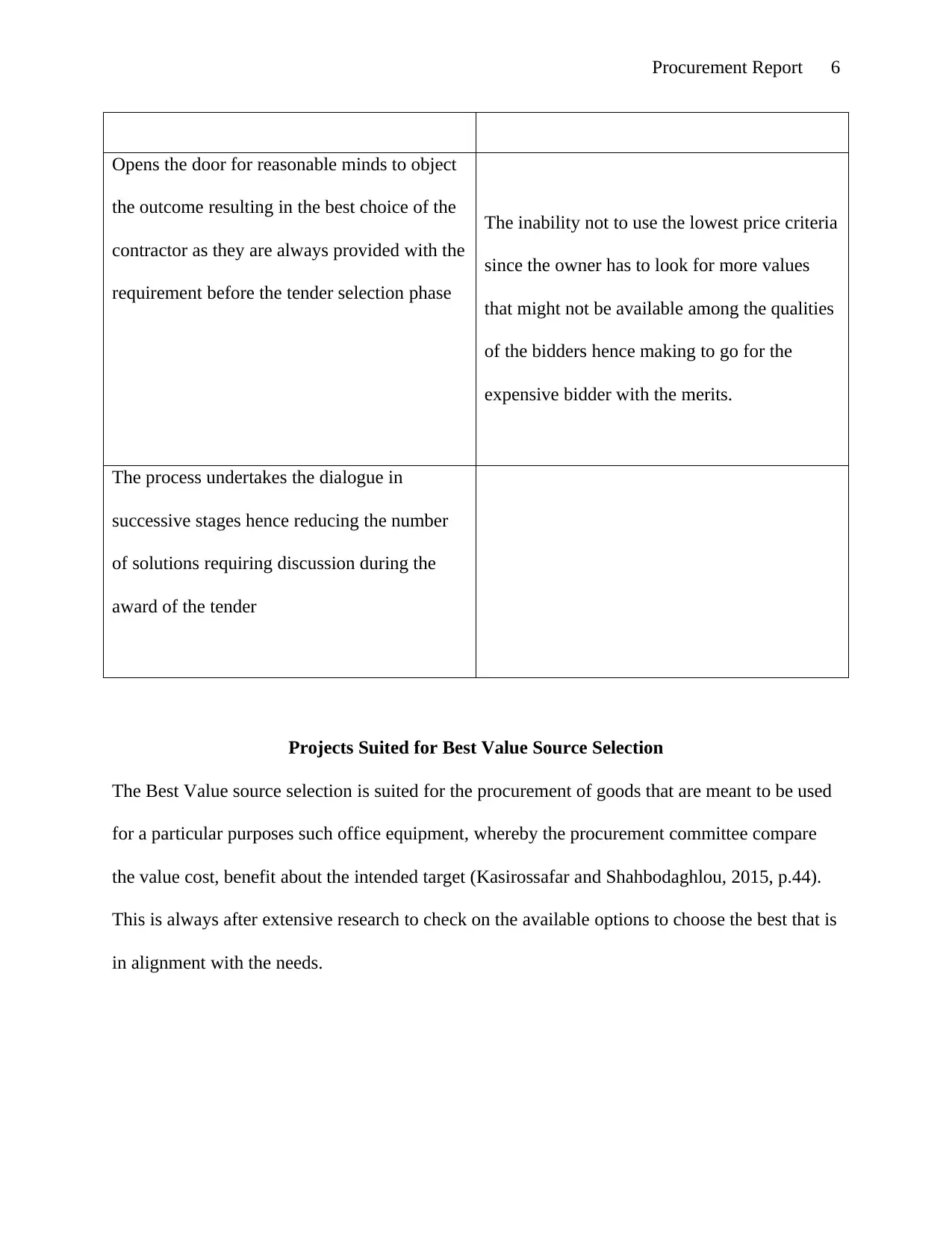
Procurement Report 6
Opens the door for reasonable minds to object
the outcome resulting in the best choice of the
contractor as they are always provided with the
requirement before the tender selection phase
The inability not to use the lowest price criteria
since the owner has to look for more values
that might not be available among the qualities
of the bidders hence making to go for the
expensive bidder with the merits.
The process undertakes the dialogue in
successive stages hence reducing the number
of solutions requiring discussion during the
award of the tender
Projects Suited for Best Value Source Selection
The Best Value source selection is suited for the procurement of goods that are meant to be used
for a particular purposes such office equipment, whereby the procurement committee compare
the value cost, benefit about the intended target (Kasirossafar and Shahbodaghlou, 2015, p.44).
This is always after extensive research to check on the available options to choose the best that is
in alignment with the needs.
Opens the door for reasonable minds to object
the outcome resulting in the best choice of the
contractor as they are always provided with the
requirement before the tender selection phase
The inability not to use the lowest price criteria
since the owner has to look for more values
that might not be available among the qualities
of the bidders hence making to go for the
expensive bidder with the merits.
The process undertakes the dialogue in
successive stages hence reducing the number
of solutions requiring discussion during the
award of the tender
Projects Suited for Best Value Source Selection
The Best Value source selection is suited for the procurement of goods that are meant to be used
for a particular purposes such office equipment, whereby the procurement committee compare
the value cost, benefit about the intended target (Kasirossafar and Shahbodaghlou, 2015, p.44).
This is always after extensive research to check on the available options to choose the best that is
in alignment with the needs.
⊘ This is a preview!⊘
Do you want full access?
Subscribe today to unlock all pages.

Trusted by 1+ million students worldwide
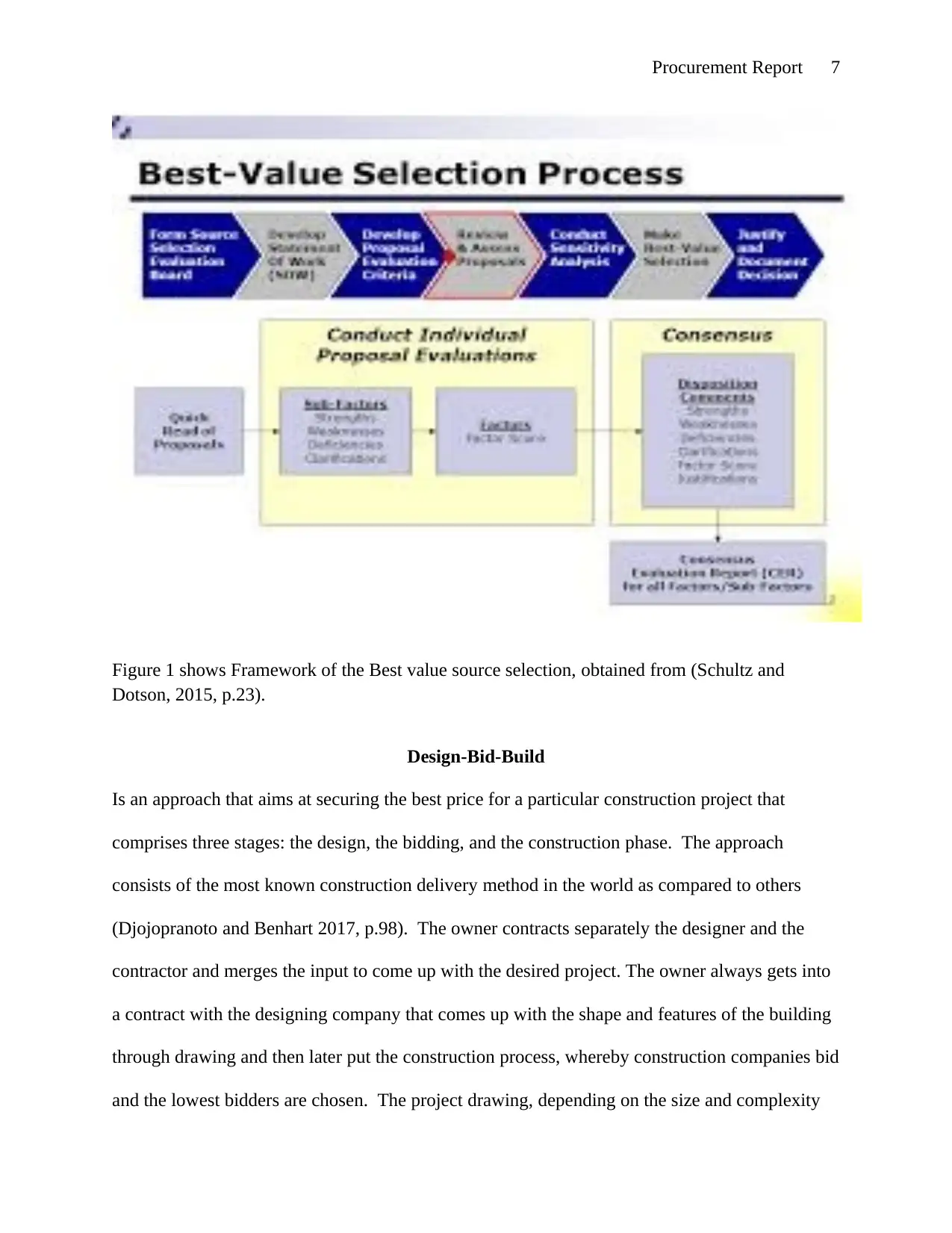
Procurement Report 7
Figure 1 shows Framework of the Best value source selection, obtained from (Schultz and
Dotson, 2015, p.23).
Design-Bid-Build
Is an approach that aims at securing the best price for a particular construction project that
comprises three stages: the design, the bidding, and the construction phase. The approach
consists of the most known construction delivery method in the world as compared to others
(Djojopranoto and Benhart 2017, p.98). The owner contracts separately the designer and the
contractor and merges the input to come up with the desired project. The owner always gets into
a contract with the designing company that comes up with the shape and features of the building
through drawing and then later put the construction process, whereby construction companies bid
and the lowest bidders are chosen. The project drawing, depending on the size and complexity
Figure 1 shows Framework of the Best value source selection, obtained from (Schultz and
Dotson, 2015, p.23).
Design-Bid-Build
Is an approach that aims at securing the best price for a particular construction project that
comprises three stages: the design, the bidding, and the construction phase. The approach
consists of the most known construction delivery method in the world as compared to others
(Djojopranoto and Benhart 2017, p.98). The owner contracts separately the designer and the
contractor and merges the input to come up with the desired project. The owner always gets into
a contract with the designing company that comes up with the shape and features of the building
through drawing and then later put the construction process, whereby construction companies bid
and the lowest bidders are chosen. The project drawing, depending on the size and complexity
Paraphrase This Document
Need a fresh take? Get an instant paraphrase of this document with our AI Paraphraser
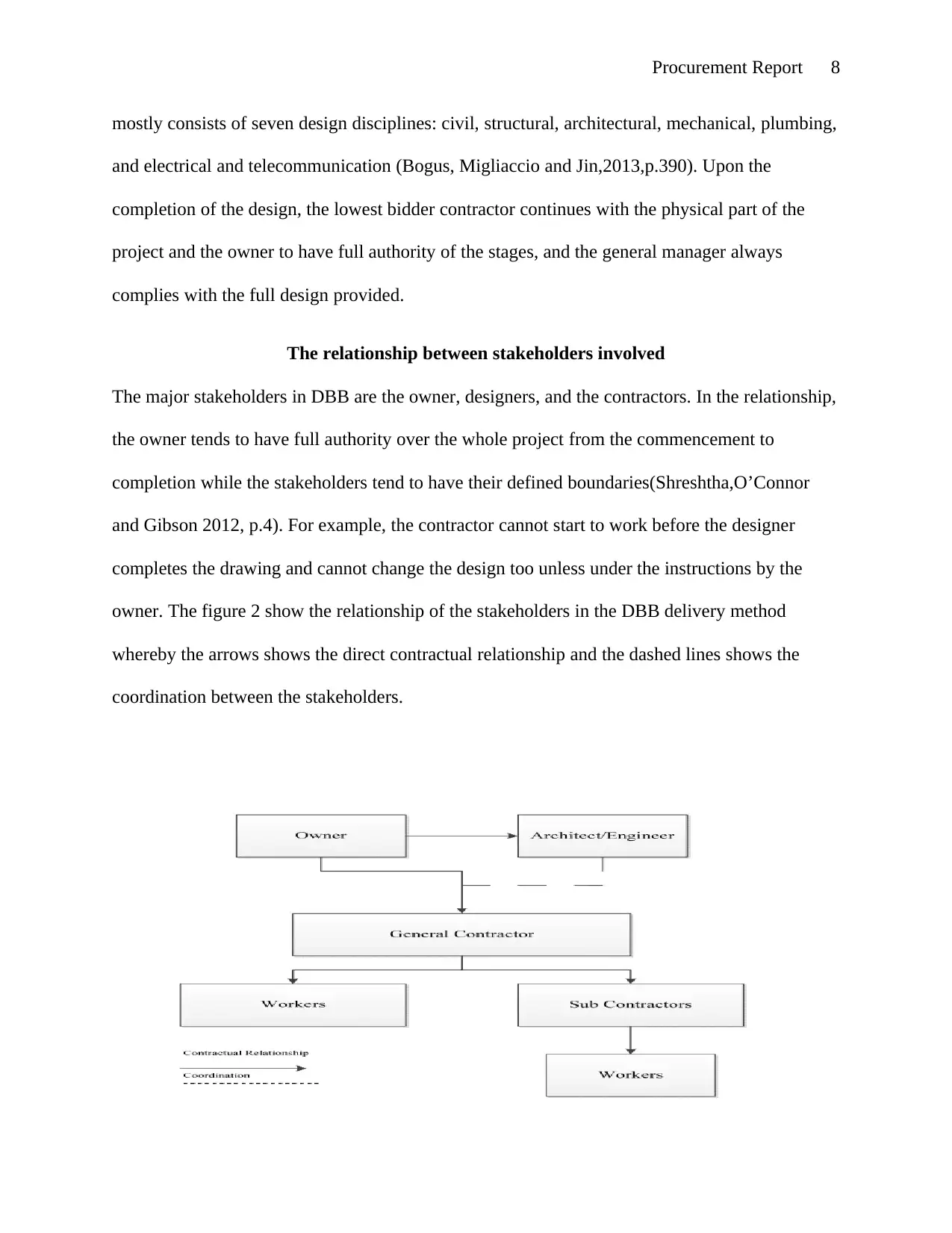
Procurement Report 8
mostly consists of seven design disciplines: civil, structural, architectural, mechanical, plumbing,
and electrical and telecommunication (Bogus, Migliaccio and Jin,2013,p.390). Upon the
completion of the design, the lowest bidder contractor continues with the physical part of the
project and the owner to have full authority of the stages, and the general manager always
complies with the full design provided.
The relationship between stakeholders involved
The major stakeholders in DBB are the owner, designers, and the contractors. In the relationship,
the owner tends to have full authority over the whole project from the commencement to
completion while the stakeholders tend to have their defined boundaries(Shreshtha,O’Connor
and Gibson 2012, p.4). For example, the contractor cannot start to work before the designer
completes the drawing and cannot change the design too unless under the instructions by the
owner. The figure 2 show the relationship of the stakeholders in the DBB delivery method
whereby the arrows shows the direct contractual relationship and the dashed lines shows the
coordination between the stakeholders.
mostly consists of seven design disciplines: civil, structural, architectural, mechanical, plumbing,
and electrical and telecommunication (Bogus, Migliaccio and Jin,2013,p.390). Upon the
completion of the design, the lowest bidder contractor continues with the physical part of the
project and the owner to have full authority of the stages, and the general manager always
complies with the full design provided.
The relationship between stakeholders involved
The major stakeholders in DBB are the owner, designers, and the contractors. In the relationship,
the owner tends to have full authority over the whole project from the commencement to
completion while the stakeholders tend to have their defined boundaries(Shreshtha,O’Connor
and Gibson 2012, p.4). For example, the contractor cannot start to work before the designer
completes the drawing and cannot change the design too unless under the instructions by the
owner. The figure 2 show the relationship of the stakeholders in the DBB delivery method
whereby the arrows shows the direct contractual relationship and the dashed lines shows the
coordination between the stakeholders.
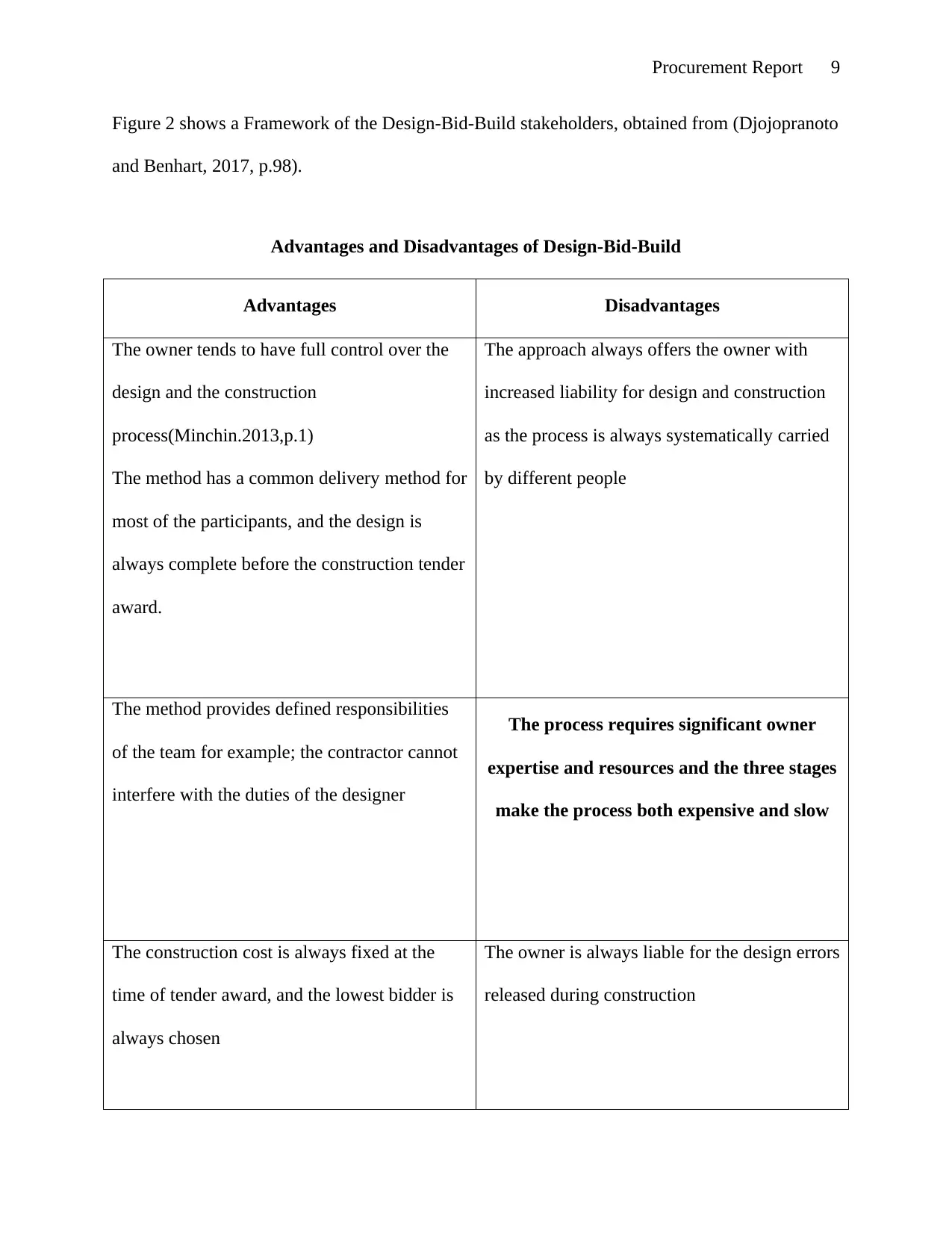
Procurement Report 9
Figure 2 shows a Framework of the Design-Bid-Build stakeholders, obtained from (Djojopranoto
and Benhart, 2017, p.98).
Advantages and Disadvantages of Design-Bid-Build
Advantages Disadvantages
The owner tends to have full control over the
design and the construction
process(Minchin.2013,p.1)
The method has a common delivery method for
most of the participants, and the design is
always complete before the construction tender
award.
The approach always offers the owner with
increased liability for design and construction
as the process is always systematically carried
by different people
The method provides defined responsibilities
of the team for example; the contractor cannot
interfere with the duties of the designer
The process requires significant owner
expertise and resources and the three stages
make the process both expensive and slow
The construction cost is always fixed at the
time of tender award, and the lowest bidder is
always chosen
The owner is always liable for the design errors
released during construction
Figure 2 shows a Framework of the Design-Bid-Build stakeholders, obtained from (Djojopranoto
and Benhart, 2017, p.98).
Advantages and Disadvantages of Design-Bid-Build
Advantages Disadvantages
The owner tends to have full control over the
design and the construction
process(Minchin.2013,p.1)
The method has a common delivery method for
most of the participants, and the design is
always complete before the construction tender
award.
The approach always offers the owner with
increased liability for design and construction
as the process is always systematically carried
by different people
The method provides defined responsibilities
of the team for example; the contractor cannot
interfere with the duties of the designer
The process requires significant owner
expertise and resources and the three stages
make the process both expensive and slow
The construction cost is always fixed at the
time of tender award, and the lowest bidder is
always chosen
The owner is always liable for the design errors
released during construction
⊘ This is a preview!⊘
Do you want full access?
Subscribe today to unlock all pages.

Trusted by 1+ million students worldwide
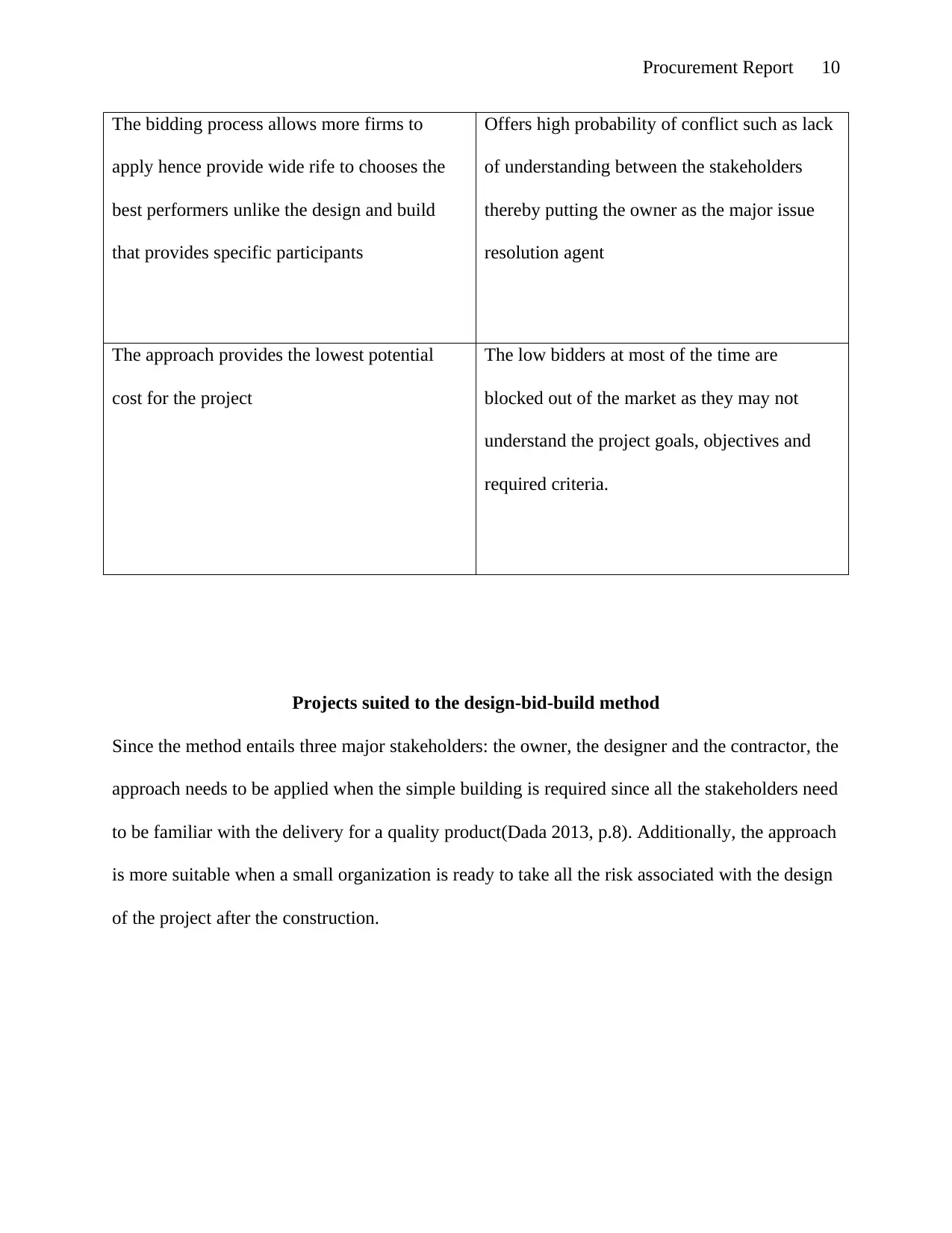
Procurement Report 10
The bidding process allows more firms to
apply hence provide wide rife to chooses the
best performers unlike the design and build
that provides specific participants
Offers high probability of conflict such as lack
of understanding between the stakeholders
thereby putting the owner as the major issue
resolution agent
The approach provides the lowest potential
cost for the project
The low bidders at most of the time are
blocked out of the market as they may not
understand the project goals, objectives and
required criteria.
Projects suited to the design-bid-build method
Since the method entails three major stakeholders: the owner, the designer and the contractor, the
approach needs to be applied when the simple building is required since all the stakeholders need
to be familiar with the delivery for a quality product(Dada 2013, p.8). Additionally, the approach
is more suitable when a small organization is ready to take all the risk associated with the design
of the project after the construction.
The bidding process allows more firms to
apply hence provide wide rife to chooses the
best performers unlike the design and build
that provides specific participants
Offers high probability of conflict such as lack
of understanding between the stakeholders
thereby putting the owner as the major issue
resolution agent
The approach provides the lowest potential
cost for the project
The low bidders at most of the time are
blocked out of the market as they may not
understand the project goals, objectives and
required criteria.
Projects suited to the design-bid-build method
Since the method entails three major stakeholders: the owner, the designer and the contractor, the
approach needs to be applied when the simple building is required since all the stakeholders need
to be familiar with the delivery for a quality product(Dada 2013, p.8). Additionally, the approach
is more suitable when a small organization is ready to take all the risk associated with the design
of the project after the construction.
Paraphrase This Document
Need a fresh take? Get an instant paraphrase of this document with our AI Paraphraser
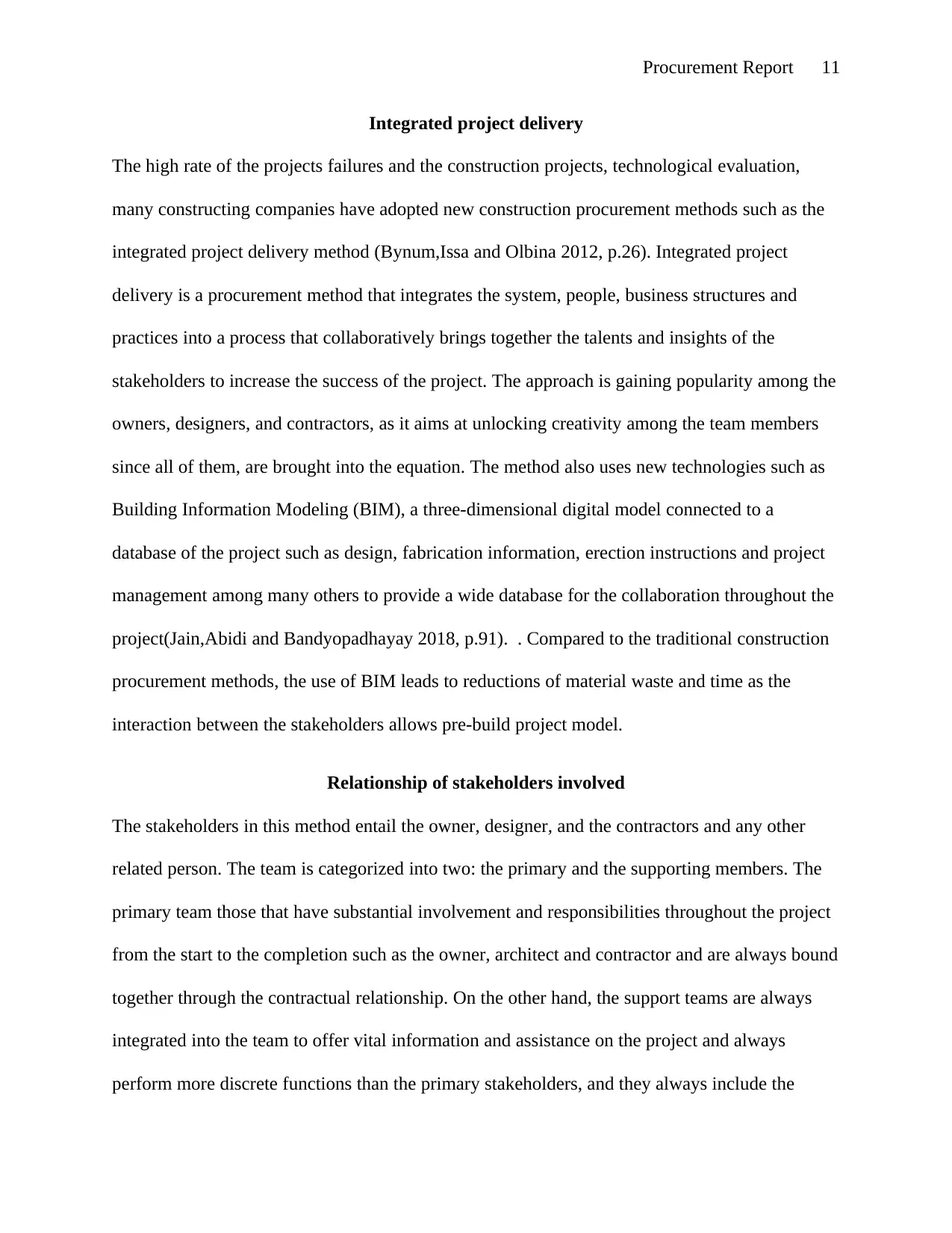
Procurement Report 11
Integrated project delivery
The high rate of the projects failures and the construction projects, technological evaluation,
many constructing companies have adopted new construction procurement methods such as the
integrated project delivery method (Bynum,Issa and Olbina 2012, p.26). Integrated project
delivery is a procurement method that integrates the system, people, business structures and
practices into a process that collaboratively brings together the talents and insights of the
stakeholders to increase the success of the project. The approach is gaining popularity among the
owners, designers, and contractors, as it aims at unlocking creativity among the team members
since all of them, are brought into the equation. The method also uses new technologies such as
Building Information Modeling (BIM), a three-dimensional digital model connected to a
database of the project such as design, fabrication information, erection instructions and project
management among many others to provide a wide database for the collaboration throughout the
project(Jain,Abidi and Bandyopadhayay 2018, p.91). . Compared to the traditional construction
procurement methods, the use of BIM leads to reductions of material waste and time as the
interaction between the stakeholders allows pre-build project model.
Relationship of stakeholders involved
The stakeholders in this method entail the owner, designer, and the contractors and any other
related person. The team is categorized into two: the primary and the supporting members. The
primary team those that have substantial involvement and responsibilities throughout the project
from the start to the completion such as the owner, architect and contractor and are always bound
together through the contractual relationship. On the other hand, the support teams are always
integrated into the team to offer vital information and assistance on the project and always
perform more discrete functions than the primary stakeholders, and they always include the
Integrated project delivery
The high rate of the projects failures and the construction projects, technological evaluation,
many constructing companies have adopted new construction procurement methods such as the
integrated project delivery method (Bynum,Issa and Olbina 2012, p.26). Integrated project
delivery is a procurement method that integrates the system, people, business structures and
practices into a process that collaboratively brings together the talents and insights of the
stakeholders to increase the success of the project. The approach is gaining popularity among the
owners, designers, and contractors, as it aims at unlocking creativity among the team members
since all of them, are brought into the equation. The method also uses new technologies such as
Building Information Modeling (BIM), a three-dimensional digital model connected to a
database of the project such as design, fabrication information, erection instructions and project
management among many others to provide a wide database for the collaboration throughout the
project(Jain,Abidi and Bandyopadhayay 2018, p.91). . Compared to the traditional construction
procurement methods, the use of BIM leads to reductions of material waste and time as the
interaction between the stakeholders allows pre-build project model.
Relationship of stakeholders involved
The stakeholders in this method entail the owner, designer, and the contractors and any other
related person. The team is categorized into two: the primary and the supporting members. The
primary team those that have substantial involvement and responsibilities throughout the project
from the start to the completion such as the owner, architect and contractor and are always bound
together through the contractual relationship. On the other hand, the support teams are always
integrated into the team to offer vital information and assistance on the project and always
perform more discrete functions than the primary stakeholders, and they always include the

Procurement Report 12
consultants and the sub-contractors. The IPD entails legal relationship that dictates that risk and
reward are shared among the stakeholders since all are equally vested, unlike the DBB delivery
methods that always put the stakeholders at opposite sides of the spectrum, resulting into
targeting blames in case of a problem. Therefore, the stakeholders always have constituted
management committee that makes the strategic decisions that are not always hierarchical rather
collaborative even from the junior staffs to have optimal solutions.
The approach constitutes of four major stages that is conceptualization stage that brings all the
stakeholders together to analyze different solutions to enhance the project delivery by creating a
less-complicated process, eliminating errors and minimizing the re-design problems. The design
stage requires the evaluations of the project as the construction code regulations are set to reduce
material waste(Zhang ,He and Zhou 2013, p.798). The implementation stage starts with the
computer modeling and design data analysis through the use of BIM to test and ensure that the
construction project is achievable, finally, the construction stage whereby the actual physical
aspects of the project takes place following the laid down procedures and regulations.
Advantages and Disadvantages of Integrated Project Delivery
Advantages Disadvantages
Allows sharing of ideas and project
information among the stakeholders hence
results into successful project delivery (El
Asmar,Hanna and Loh 2013, p.1)
The method is not widely familiar with most of
the construction procurement companies hence
make it difficult to implement(Fish and Keen
2012, p.91)
The IPD allows for extensive pre-0construction
efforts that are related to the identification and
The method tends to be expensive in term of
time and cost, as numerous stakeholders views
consultants and the sub-contractors. The IPD entails legal relationship that dictates that risk and
reward are shared among the stakeholders since all are equally vested, unlike the DBB delivery
methods that always put the stakeholders at opposite sides of the spectrum, resulting into
targeting blames in case of a problem. Therefore, the stakeholders always have constituted
management committee that makes the strategic decisions that are not always hierarchical rather
collaborative even from the junior staffs to have optimal solutions.
The approach constitutes of four major stages that is conceptualization stage that brings all the
stakeholders together to analyze different solutions to enhance the project delivery by creating a
less-complicated process, eliminating errors and minimizing the re-design problems. The design
stage requires the evaluations of the project as the construction code regulations are set to reduce
material waste(Zhang ,He and Zhou 2013, p.798). The implementation stage starts with the
computer modeling and design data analysis through the use of BIM to test and ensure that the
construction project is achievable, finally, the construction stage whereby the actual physical
aspects of the project takes place following the laid down procedures and regulations.
Advantages and Disadvantages of Integrated Project Delivery
Advantages Disadvantages
Allows sharing of ideas and project
information among the stakeholders hence
results into successful project delivery (El
Asmar,Hanna and Loh 2013, p.1)
The method is not widely familiar with most of
the construction procurement companies hence
make it difficult to implement(Fish and Keen
2012, p.91)
The IPD allows for extensive pre-0construction
efforts that are related to the identification and
The method tends to be expensive in term of
time and cost, as numerous stakeholders views
⊘ This is a preview!⊘
Do you want full access?
Subscribe today to unlock all pages.

Trusted by 1+ million students worldwide
1 out of 18
Related Documents
Your All-in-One AI-Powered Toolkit for Academic Success.
+13062052269
info@desklib.com
Available 24*7 on WhatsApp / Email
![[object Object]](/_next/static/media/star-bottom.7253800d.svg)
Unlock your academic potential
Copyright © 2020–2025 A2Z Services. All Rights Reserved. Developed and managed by ZUCOL.




